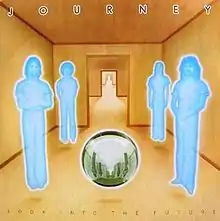Look into the Future
Look into the Future is the second studio album by Journey. It was released in January 1976 on Columbia Records.
| Look into the Future | ||||
|---|---|---|---|---|
 | ||||
| Studio album by | ||||
| Released | January, 1976 | |||
| Recorded | August–October 1975 | |||
| Studio | The Automatt, San Francisco, California | |||
| Genre | Progressive rock, jazz fusion[1] | |||
| Length | 41:50 | |||
| Label | Columbia | |||
| Producer | Journey and Glen Kolotkin | |||
| Journey chronology | ||||
| ||||
| Singles from Look into the Future | ||||
| ||||
| Review scores | |
|---|---|
| Source | Rating |
| AllMusic | |
For their second album, the members of Journey toned down the overt progressiveness of their first, self-titled release, in favor of a more focused approach.[1] Despite that, Look into the Future still retains some of the experimental approach and sound of the debut,[1] especially in the title track and "I'm Gonna Leave You". The album also features a cover version of The Beatles' "It's All Too Much" from the 1968 Yellow Submarine film and 1969 soundtrack. The title track was the longest recorded Journey song until 1980, when "Destiny" from Dream, After Dream would claim that honor.
Guitarist George Tickner left the band after having co-written two songs for this album, leaving members Gregg Rolie (lead vocals/keyboards), Neal Schon (guitar), Ross Valory (bass), and Aynsley Dunbar (drums).
Track listing
| No. | Title | Lyrics | Music | Length |
|---|---|---|---|---|
| 1. | "On a Saturday Nite" | Gregg Rolie | Rolie | 4:01 |
| 2. | "It's All Too Much" | George Harrison | Harrison | 4:06 |
| 3. | "Anyway" | Rolie | Rolie | 4:12 |
| 4. | "She Makes Me (Feel Alright)" | Alex Cash, Rolie | Neal Schon | 3:13 |
| 5. | "You're on Your Own" | Rolie | George Tickner, Schon | 5:55 |
| No. | Title | Lyrics | Music | Length |
|---|---|---|---|---|
| 6. | "Look into the Future" | Diane Valory, Rolie | Schon | 8:13 |
| 7. | "Midnight Dreamer" | Rolie | Schon | 5:14 |
| 8. | "I'm Gonna Leave You" | Rolie | Schon, Rolie, Tickner | 7:01 |
Personnel
Journey
- Gregg Rolie – vocals, keyboards
- Neal Schon – guitar
- Ross Valory – bass guitar
- Aynsley Dunbar – drums
Production
- Glen Kolotkin – co-producer, engineer
- Mark Friedman – engineer
- George Horn – mastering
- Rick Narin – artwork
- Ethan Russell – photography
References
- Erlewine, Stephen Thomas. "Journey Look into the Future review". AllMusic. All Media Network. Retrieved 2013-06-30.
External links
- Journey - Look into the Future (1976) album review by Stephen Thomas Erlewine, credits and releases at AllMusic.com
- Journey - Look into the Future (1976) album releases & credits at Discogs.com
- Journey - Look into the Future (1976) album credits & user reviews at ProgArchives.com
- Journey - Look into the Future (1976) album to be listened as stream at Play.Spotify.com